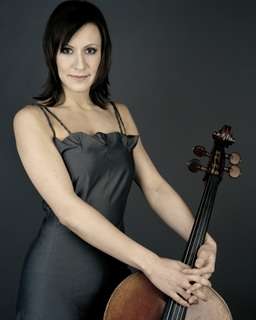|
Back
From Peaceful Meditation to Emotional Nostalgia Hong Kong
Hong Kong City Hall, Concert Hall
08/29/2009 -
Arvo Pärt: Cantus in Memory of Benjamin Britten for String orchestra & Bell
Ludwig van Beethoven: Symphony No 7 in A major, Op 92
Antonín Dvorák: Cello Concerto in B minor, Op 104
Tatjana Vassiljeva (Cello)
Hong Kong Sinfonietta, James Tuggle (Conductor)

Tatjana Vassiljeva (© Felix Broede)
In Hong Kong Sinfonietta’s coming season, Beethoven plays a central role. But the program of Saturday’s concert was a fresh combination – a contemporary miniature together with a classical symphony and a romantic concerto.
However, perhaps not many audiences realized, both compositions in the first half were written in the key of A. Pärt’s Cantus, anextended tonal elegy, served as a fresh curtain riser of the evening, and provided coherent transition to the following Beethoven’s Symphony. Arvo Pärt is a loyal disciple of Benjamin Britten – he described Britten as ‘possessing the unusual purity that he himself sought as a composer.’ The Cantus in Memory of Benjamin Britten was composed for the purpose of mourning Britten’s death in 1976. For people in the anti-Bush camp, the piece must have sounded familiar, since the opening bars of it were used in the political film Fahrenheit 9/11 during a scene showing the aftermath of the attacks on the World Trade Center. The music opened with three beats of silence, followed by the tubular bell in pianissimo, which delineates the death of Britten. Under Mr. Tuggle’s baton, the bell began with a barely audible whisper, paving the way for the vaporous string entry, which sounded a little curt in comparison. When the music was pushed to the climax, particularly at the moment when violins sustained the middle C, their pace sounded a little languid and sluggish. Where most interpretations underlined the music’s emotional intensity of despair and desperation, Mr. Tuggle ended the funeral with a rather peaceful conclusion, bestowing a reverent blessing to Britten’s mausoleum.
Hong Kong Sinfonietta’s chamber-scale intonation was more appropriate to Beethoven’s music – the dry timpani and glinting violins sounded very classical indeed. Conductor Tuggle displayed his exquisite musicianship by delicately articulated details and polished melodies. The elegant and tender woodwind dialogues in the first movement were exceptionally blissful and memorable. The second movement, comparing to the opening Cantus, seemed better paced and finely structured. Mr. Tuggle did not rendered this Allegretto movement like a funeral march, as many conductors do. Instead, the melodies at different voices were all daintily polished, and it was this overtly expressive treatment that bleached the contrasting colors between the minor and major sections, dispatching the movement as an intact entity. The whirlwind Scherzo was more like a rural dance rather than an elegant minuet. The conductor ignored all the repeats, making the movement a momentary excitement before the real climax at the end of the fourth movement. Though the passageworks and intricate textures in the last movement brought the players some bustles, the whole Symphony ended in a hectic thunder in fff that moved the audience to the edge of their seats.
After the intermission, exuberant Russian cellist Tatjana Vassiljeva joined the Sinfonietta for Dvorák’s Cello Concerto, a standard repertoire for every cellist. Looking effeminate and feminine, Ms. Vassiljeva was actually very masculine when she put her bow on the strings. In contrast to the orchestra’s soft-edged interpretation, her playing was a real ‘Grandioso’. The florescent tone and steely power was exactly what Dvorák needs, nonetheless, it was never brash and impudent. Ms. Vassiljeva possesses a solid technique that enabled her to overcome the technical hurdles without strain, notwithstanding some flat pitches during the double-stop passage near the end of the first movement, an extremely challenging passage even for the most technically consummate cellists.
Despite her projecting tone, Ms. Vassiljeva was very aware of her collaboration and balance with the orchestra, a crucial element for this symphony-like concerto. When she was playing some accompanying figures, her voice was so tender and gentle that it never overshadowed the orchestral melodies. Her affectionate expressivity was also tellingly exemplified in the slow movement, in which the rapt dialogues between the solo and the orchestra were lucidly brought to the surface. Her crisp articulation and teeming energy transformed the last movement into a Slavonic dance. It was a pity that the bass-lacking orchestral sonority inhibited some vivacity of this movement (I wonder if six cellos were enough for this massive concerto). The fervent climax at the end electrified the nerves of every attendee, whose fiery emotions could not be cooled down without an encore.
Even though her deep red skirt was drenched with sweat, Ms. Vassiljeva generously delivered two movements from J.S. Bach’s Cello Suites, a cycle she recently recorded with Mirare. Tatjana Vassiljeva is definitely a cellist to watch.
Hong Kong Sinfonietta’s Website
Tatjana Vassiljeva’s Website
Danny Kim-Nam Hui
|